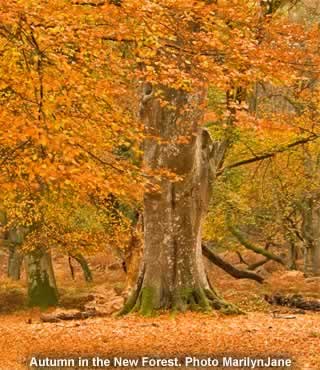The New Forest |
|
 |
|||
An ancient hunting ground that's now a National Park |
||
Listen to this article |
||
The New Forest takes up a large chunk of Hampshire, not far from Southampton and Bournemouth. Obviously there are hundreds of trees, but you'll also find plenty of open grassland, filled with grazing cattle. |
||
The forest's official borders were set up nearly 1000 years ago by William the Conqueror. His name for it was the "New Hunting Forest", as he enjoyed tracking down the native deer. He set up various laws to protect the area, in order to guarantee that there would always be animals for him to hunt. The penalties for interfering with the monarch's forest were extremely severe. |
||
Of course, in the modern age things are very different to how they were back then. The New Forest is still protected by law though. In 2005 it became an official National Park, ensuring its continuing preservation. There are 571 square kilometres within its borders, making it the smallest National Park in the UK. Even so, that doesn't mean you're likely to run out of things to see. |
||
The forest can be explored in many different ways. There are over 160 kilometres of cycle routes, and countless places to hire bikes. It also has around a dozen stables, offering the chance to ride on horseback like William the Conqueror once did! In the summer, an open top tour bus gives visitors a flavour of what the National Park has to offer. |
||
However, the most common method of traversing the forest is on foot. There are hundreds of paths, and relatively few restrictions on where you can go. That makes walking the best way to really explore all the park's nooks and crannies. The area is well set up with facilities like car parks and picnic tables, making it easy to plan your route. Most of the land is relatively flat, meaning that any walk you choose to go on shouldn't be overly strenuous. The only things to watch out for are the bogs! If you're not careful, you'll get wet feet when you're least expecting it. |
||
Various hamlets and villages are scattered throughout the New Forest. These are mostly quiet, relaxing places - but that doesn't make them boring. Many of the settlements highlight a particular part of the area's history. At Buckler's Hard, for example, craftsmen used timber from the wood to make ships for Nelson's fleet. Later, it was used by the Navy in World War II. A small museum documents the village's history and achievements. |
||
There's another good exhibition nearby, at the National Motor Museum. Its collection includes over 250 vehicles from all eras. You'll also find some more unusual objects, like an artificial human hand that was used for signalling. The museum is situated in the village of Beaulieu, which also includes the fairy-tale-like Palace House. |
||
The settlement of Lyndhurst, at the centre of the park, is one of the best places to find cafés, pubs and shops. This is where William the Conqueror first set up his hunting grounds, back in the 11th century. Ever since then it has been considered the capital of the forest, and most visitors end up passing through here at some point. The village is home to the New Forest Centre. This building has a museum, giving a detailed history of the area, and a Visitor Centre, showing you the best ways to enjoy it. |
||
|
||
National Motor Museum is open daily from 10am to 6pm (5pm in winter). Entry to Beaulieu costs around £16.50 for adults, £9 for children. Brockenhurst, Hampshire, SO42 7ZN. Tel: 01590 614 650 |
||
New Forest Centre is open daily from 10am to 5pm. Entry to the centre is FREE. Entry to the museum costs around £3 for adults, FREE for children. Lyndhurst, Hampshire, SO43 7NY. Tel: 02380 283 444 |
||
|
Pocket Britain is optimised for use on a smartphone or tablet with internet access. All content is subject to copyright. All reasonable methods have been used to ensure information supplied is accurate at the time of publication. However, it is advisable to check information before relying on it. Privacy Policy |